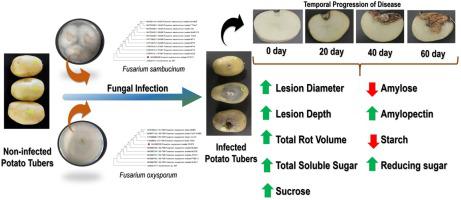Postharvest Biology and Technology ( IF 6.4 ) Pub Date : 2021-07-06 , DOI: 10.1016/j.postharvbio.2021.111638 Rahul Kumar Tiwari 1, 2 , Bishnu Maya Bashyal 1 , V. Shanmugam 1 , Milan Kumar Lal 1, 2 , Ravinder Kumar 2 , Sanjeev Sharma 2 , Vinod 1 , Kishor Gaikwad 1 , Brajesh Singh 2 , Rashmi Aggarwal 1

|
Fusarium is a major spoilage fungus of potato tubers during post-harvest storage. The dry rot disease caused by Fusarium species severely affects the harvested potatoes and impose a critical loss to processing industries and consumers. In our experiment, we investigated the occurrence of Fusarium sambucinum (FS) and Fusarium oxysporum (FO) as major storage fungus causing Fusarium dry rot in potato tubers. Further, we performed morpho-molecular identification of both the fungi and confirmed their pathogenicity on potato tuber during storage. We evaluated the susceptibility parameters and quality attributes during infection in two popular cultivars namely ‘Kufri Pukhraj’ (table purpose) and ‘Kufri Chipsona 3’ (processing purpose). Out of two cultivars, ‘Kufri Pukhraj’ was shown to have greater susceptibility as compared to ‘Kufri Chipsona 3’ in terms of lesion diameter, fungus penetration and rot volume during periodic observation of 20, 40 and 60 d of storage. FS was highly aggressive as compared to FO. However, a mixed inoculum of Fusarium species caused higher damage irrespective of cultivars. The physicochemical analysis revealed that fungus infection (individual or mixed inoculum) leads to a reduction in starch and amylose content in both the cultivars after 60 d of storage. Moreover, amylopectin, reducing sugars, sucrose and total soluble sugar content were increased in response to fungal infection in both cultivars. Pearson correlation analysis indicated that lesion diameter and rot volume was negatively correlated (R < -0.80) with starch and amylose content. However, amylopectin, reducing sugar, sucrose and total soluble sugar was positively correlated with susceptibility parameters. This study highlights the impact of storage fungus infection on the nutritional quality parameters of potato tubers which is a critical concern for consumers and processing industries.
中文翻译:

镰刀菌干腐病对马铃薯收获后贮藏期块茎理化特性的影响
镰刀菌是马铃薯块茎在收获后储存期间的主要腐败真菌。由镰刀菌引起的干腐病严重影响收获的马铃薯,并对加工业和消费者造成严重损失。在我们的实验中,我们调查了镰刀菌(FS) 和尖孢镰刀菌(FO) 作为导致镰刀菌病的主要储藏真菌的发生情况。马铃薯块茎干腐病。此外,我们对这两种真菌进行了形态分子鉴定,并证实了它们在储存过程中对马铃薯块茎的致病性。我们评估了两种流行品种感染期间的易感性参数和质量属性,即“Kufri Pukhraj”(餐桌用途)和“Kufri Chipsona 3”(加工用途)。在 20、40 和 60 天的定期观察期间,在两个栽培品种中,与 'Kufri Chipsona 3' 相比,'Kufri Pukhraj' 在病斑直径、真菌渗透和腐烂体积方面表现出更大的敏感性。与 FO 相比,FS 具有很强的攻击性。然而,镰刀菌的混合接种物无论品种如何,物种都会造成更高的损害。理化分析表明,真菌感染(单独或混合接种)导致两个品种在贮藏 60 天后淀粉和直链淀粉含量降低。此外,支链淀粉、还原糖、蔗糖和总可溶性糖含量在两个品种中都因真菌感染而增加。Pearson相关分析表明病斑直径和腐烂体积与淀粉和直链淀粉含量呈负相关(R < -0.80)。然而,支链淀粉、还原糖、蔗糖和总可溶性糖与药敏参数呈正相关。这项研究强调了贮藏真菌感染对马铃薯块茎营养质量参数的影响,这是消费者和加工业的一个关键问题。











































 京公网安备 11010802027423号
京公网安备 11010802027423号